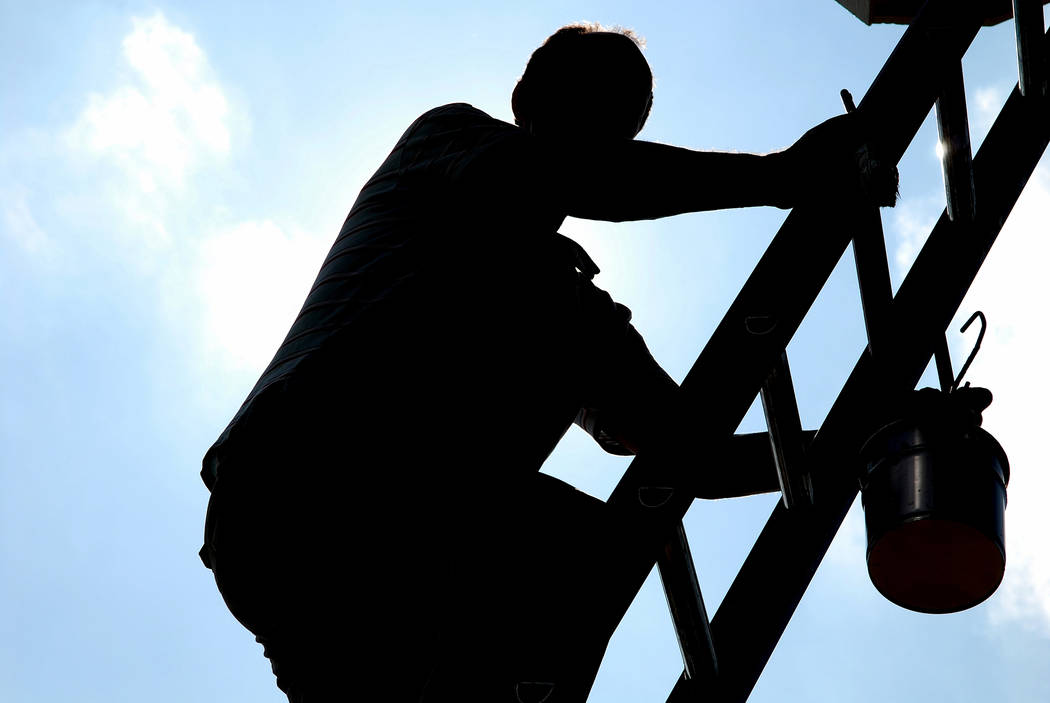Fiberglass ladder is sturdier than aluminum one
Q: My homeowners association sent me a letter stating that I need to paint the fascia of my roof. It is fairly high up, so I need an extension ladder of around 30 feet. I’m wondering if I should get an aluminum ladder or a fiberglass one, and how do I maneuver it around?
A: If my skinny rear end had to be elevated 30 feet off the ground, it would be on a fiberglass ladder. Not only are they poor conductors of electricity, which is good if you’ll be working around overhead power lines, but they are heavier and more sturdy than aluminum ladders. I think fiberglass just feels more solid than aluminum. Plus most of them are orange, and I look good in orange (or at least perched atop an orange ladder).
For your situation, I would rent the ladder for roughly $40 per day, rather than buying one for several hundred dollars.
Ladders receive a rating from the American Ladder Institute — yes, there really is such an institute — according to their material and the total weight they can carry. Ladder ratings vary from Type III, which can handle as much as 200 pounds, all the way to Type IAA, which can handle as much as 375 pounds.
Each ladder has its rating and weight capacity stamped on the side, with some general safety information. Every year, more than 500,000 people are injured by falls involving ladders, according to the institute.
A ladder this size might be tough to move around because it can weigh as much as 120 pounds. Perhaps a helpful neighbor might be at your disposal if he’s willing.
Standing the ladder up might be a chore all by itself. You can have your neighbor hold the bottom of the ladder to the ground while you hoist the other end of it up by pushing it up, rung by rung, until it is vertical. If you’re doing it alone, you can wedge the feet against a curb or wall or even drive stakes into the ground to stand it up.
Once the ladder is vertical, you have the chore of moving it; don’t try to move a fully extended ladder.
Instead, lower the ladder and move it a foot or two at a time. Grab a rung at about waist-high and another rung at around head-high and lift so that it just comes off of the ground. Use your legs, not your back. Check for obstructions on the ground and be keenly aware of the ladder’s center of gravity.
It doesn’t take much to lose control and have the ladder topple. I remember in the movie “Animal House” when Brother Bluto (John Belushi) is on the top of an extension ladder and he is moving it by jumping with it down the side of a house. I can safely say that’s definitely not the way to do it. I guess the reward of seeing a naked sorority sister was worth the risk of breaking his neck.
If you are working on a paved surface, the feet of the ladder have rubber treads to grip the surface. If you are working on grass, the feet have teeth that can rotate down to dig into the grass. As an added safety precaution, drive wooden stakes behind the bottom rung so that the ladder can’t slip out of place.
Occupational Safety and Health Administration recommends that a ladder be set at a 75-degree angle to the wall. There are a couple of quick ways to approximate this.
One is to set the ladder’s feet 1 foot out from the wall for every 4 feet of vertical rise. The other way is to stand with your toes at the foot of the ladder and stretch your arms out. Your hands should just touch the rungs in front of them.
Before you step onto the ladder, make sure it is secure and vertical. If you step on the rung and the ladder moves, get off of it and adjust it. That might mean simply moving the feet of the ladder to the left or right by an inch or two.
If you’re working on grass, you might have to shore up the feet of the ladder by digging out a little grass or adding a wood plank below the low foot. You also can buy leg levelers that bolt to the ladder’s legs to keep the ladder vertical.
You can test the stability by putting your weight on the bottom rung and slightly pulling the ladder off of the wall. The ladder will tilt if one side is low.
Once you are working, be careful about leaning too far. Keep your feet spread out against the rails of the ladder. It is much safer to move the ladder rather than lean too far and risk injury.
Mike Klimek is a licensed contractor and owner of Las Vegas Handyman. Questions may be sent by email to handymanoflasvegas@msn.com. Or, mail to 4710 W. Dewey Drive, No. 100, Las Vegas, NV 89118. His web address is www.handymanoflasvegas.com.
Do-it-yourself
Project: Using extension ladders
Cost: Rent one for around $40
Time: Varies
Difficulty: ★★























